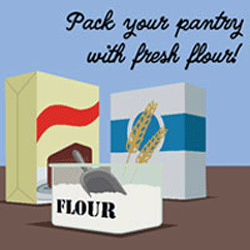Say No to Raw Dough!
 For many people, the holiday season is the perfect time to spend time together in the kitchen and share delicious baked foods and desserts. Follow these safety tips to help you and your loved ones stay healthy when handling raw dough.
For many people, the holiday season is the perfect time to spend time together in the kitchen and share delicious baked foods and desserts. Follow these safety tips to help you and your loved ones stay healthy when handling raw dough.
When you prepare homemade cookie dough, cake mixes, or even bread, you may be tempted to taste a bite before it is fully cooked. But steer clear of this temptation—eating or tasting unbaked products that are intended to be cooked, such as dough or batter, can make you sick. Children can get sick from handling or eating raw dough used for crafts or play clay, too.
Raw Dough Can Contain Bacteria That Cause Disease
Flour is typically a raw agricultural product. This means it hasn’t been treated to kill germs like Escherichia coli (E. coli). Harmful germs can contaminate grain while it’s still in the field or at other steps as flour is produced. The bacteria are killed when food made with flour is cooked. This is why you should never taste or eat raw dough or batter—whether made from recalled flour or any other flour. In 2016, an outbreak of E. coli infections linked to raw flour made 63 people sick. Flour products have long shelf lives and could be in people’s homes for a long time. If you have any recalled flour products in your home, throw them away.

Don’t taste or eat raw dough!
In addition, raw eggs that are used to make raw dough or batter can contain a germ called Salmonella that can make you sick if the eggs are eaten raw or lightly cooked. Eggs are safe to eat when cooked and handled properly.
Follow safe food handling practices when you are baking and cooking with flour and other raw ingredients:
- Do not taste or eat any raw dough or batter, whether for cookies, tortillas, pizza, biscuits, pancakes, or crafts made with raw flour, such as homemade play dough or holiday ornaments.
- Do not let children play with or eat raw dough, including dough for crafts.
- Bake or cook raw dough and batter, such as cookie dough and cake mix, before eating.
- Do not make milkshakes with products that contain raw flour, such as cake mix.
- Do not use raw, homemade cookie dough in ice cream.
- Cookie dough ice cream sold in stores contains dough that has been treated to kill harmful bacteria.
- Follow the recipe or package directions for cooking or baking at the proper temperature and for the specified time.
- Keep raw foods such as flour or eggs separate from ready-to eat-foods. Because flour is a powder, it can spread easily.
- Follow label directions to refrigerate products containing raw dough or eggs until they are cooked.
-
Clean up thoroughly after handling flour, eggs, or raw dough:
- Wash your hands with running water and soap after handling flour, raw eggs, or any surfaces that they have touched.
- Wash bowls, utensils, countertops, and other surfaces with hot water and soap.
Is recalled flour in your kitchen?

In 2016, a large outbreak of E. coli infections made people sick in 24 states. Disease detectives linked the illnesses to flour sold under several brand names, including Gold Medal, Gold Medal Wondra, and Signature Kitchens.
This flour, and baking mixes and other foods containing this flour, were recalled.
Check your pantry and throw away any recalled products.
If you stored flour in a container and no longer have the package, throw out the flour to be safe. Make sure that you clean your container with soap and hot water before using it again.
Pay Close Attention to Any Symptoms
The symptoms of E. coli infections vary for each person but often include severe stomach cramps, diarrhea (often bloody), and vomiting.
People usually get sick 3 to 4 days after swallowing the germ. Most people recover within a week. However, some people develop a serious type of kidney failure called hemolytic uremic syndrome (HUS).
The symptoms of Salmonella infections typically appear 6 to 48 hours after eating a contaminated food, though this period is sometimes longer. Symptoms typically include diarrhea, fever, and abdominal cramps. In most cases, illness lasts 4 to 7 days and people recover without antibiotics. Illness from Salmonella bacteria can be serious and is more dangerous for older adults, infants, and people with weakened immune systems.
More Information
More Information
- Page last reviewed: November 22, 2016
- Page last updated: November 22, 2016
- Content source:




 ShareCompartir
ShareCompartir